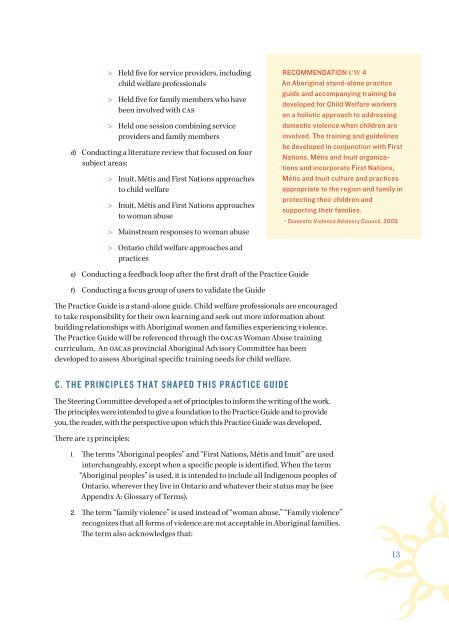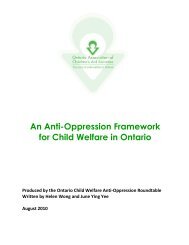English - Ontario Association of Children's Aid Societies
English - Ontario Association of Children's Aid Societies
English - Ontario Association of Children's Aid Societies
Create successful ePaper yourself
Turn your PDF publications into a flip-book with our unique Google optimized e-Paper software.
Held five for service providers, including<br />
child welfare pr<strong>of</strong>essionals<br />
> > Held five for family members who have<br />
been involved with CAS<br />
> > Held one session combining service<br />
providers and family members<br />
d) Conducting a literature review that focused on four<br />
subject areas:<br />
> > Inuit, Métis and First Nations approaches<br />
to child welfare<br />
> > Inuit, Métis and First Nations approaches<br />
to woman abuse<br />
> > Mainstream responses to woman abuse<br />
RECOMMENDATION CW 4<br />
An Aboriginal stand-alone practice<br />
guide and accompanying training be<br />
developed for Child Welfare workers<br />
on a holistic approach to addressing<br />
domestic violence when children are<br />
involved. The training and guidelines<br />
be developed in conjunction with First<br />
Nations, Métis and Inuit organizations<br />
and incorporate First Nations,<br />
Métis and Inuit culture and practices<br />
appropriate to the region and family in<br />
protecting their children and<br />
supporting their families.<br />
- Domestic Violence Advisory Council, 2009<br />
> > <strong>Ontario</strong> child welfare approaches and<br />
practices<br />
e) Conducting a feedback loop after the first draft <strong>of</strong> the Practice Guide<br />
f) Conducting a focus group <strong>of</strong> users to validate the Guide<br />
The Practice Guide is a stand-alone guide. Child welfare pr<strong>of</strong>essionals are encouraged<br />
to take responsibility for their own learning and seek out more information about<br />
building relationships with Aboriginal women and families experiencing violence.<br />
The Practice Guide will be referenced through the OACAS Woman Abuse training<br />
curriculum. An OACAS provincial Aboriginal Advisory Committee has been<br />
developed to assess Aboriginal specific training needs for child welfare.<br />
C. THE PRINCIPLES THAT SHAPED THIS PRACTICE GUIDE<br />
The Steering Committee developed a set <strong>of</strong> principles to inform the writing <strong>of</strong> the work.<br />
The principles were intended to give a foundation to the Practice Guide and to provide<br />
you, the reader, with the perspective upon which this Practice Guide was developed.<br />
There are 13 principles:<br />
1. The terms “Aboriginal peoples” and “First Nations, Métis and Inuit” are used<br />
interchangeably, except when a specific people is identified. When the term<br />
“Aboriginal peoples” is used, it is intended to include all Indigenous peoples <strong>of</strong><br />
<strong>Ontario</strong>, wherever they live in <strong>Ontario</strong> and whatever their status may be (see<br />
Appendix A: Glossary <strong>of</strong> Terms).<br />
2. The term “family violence” is used instead <strong>of</strong> “woman abuse.” “Family violence”<br />
recognizes that all forms <strong>of</strong> violence are not acceptable in Aboriginal families.<br />
The term also acknowledges that:<br />
13

















